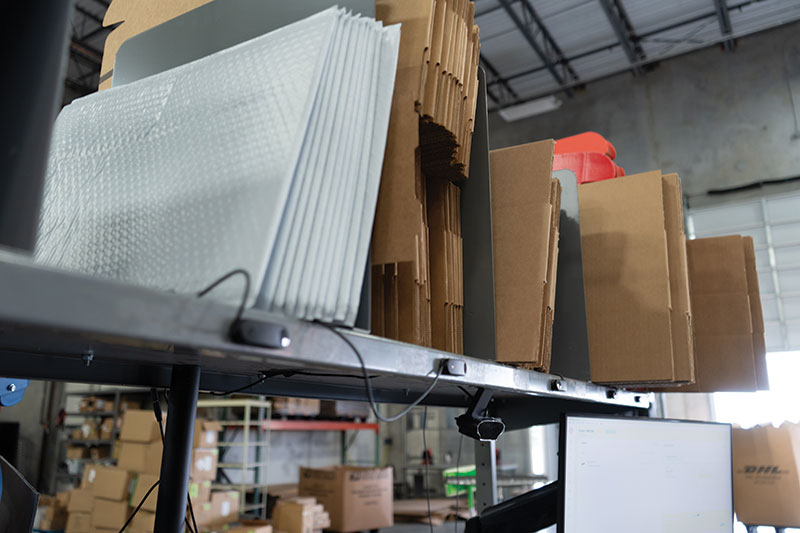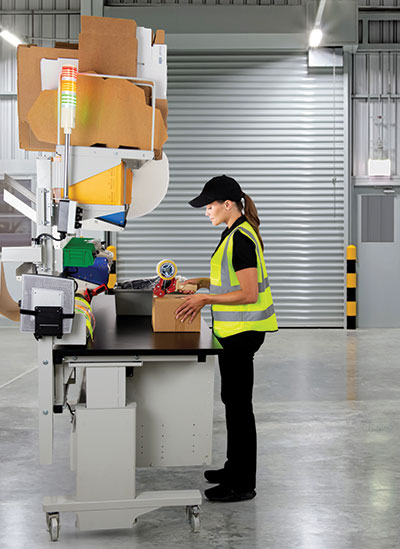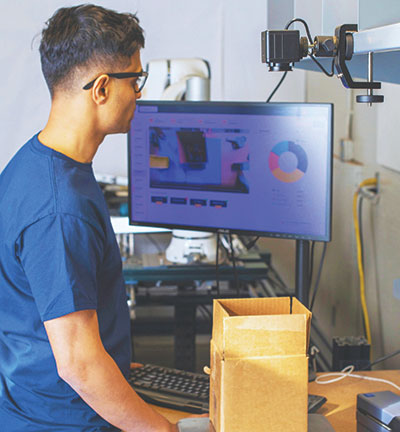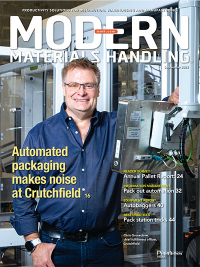Pack Station Tricks: Common sense meets tech
Industrial workstation and shelving options are abundant for effective pack-out areas. Configuring an ideal set up for your operation is part commonsense work-cell design that eliminates wasted or awkward movements, but technology can also play a role.

Cutting-edge pack stations these days feature more than organizational principles. Technology also comes into play, from minimizing keyboard interactions, to considering how goods will flow in and out of stations with automation like conveyor or mobile robots, to use of vision technology to measure effectiveness.
Pack stations can have powered conveyor running right into them to deliver ordered items. And to support transactions and tracking, the stations also need to hold technology gear like thermal printers, bar code scanners and flat screen mounts. On top of that, solutions can now use computer vision and artificial intelligence (AI) to record pack-out activity and measure the speed of each subprocess.
While technology is a factor even with manual pack out processes, establishing effective stations still revolves around keeping materials in easy reach.
“The efficiency at the station is supported by placing the various items needed for the packaging process—the inbound work, the supplies, the protective packaging, and any technology or equipment—right at the packers’ fingertips. This means within easy reach that doesn’t require excess extension, bending or twisting,” says Jeff Dehnert, president of Dehnco, a provider of workstation equipment. “Typically, the supplies and equipment can be organized to compliment the overall process where each sub-step has its required supplies or items within very easy reach.”
Get organized, get buy-in

A good first step for pack station improvements is to make a list of supplies and equipment needed, and circulate that list among top packers or “super users” of pack station systems to generate ideas and feedback, says Brandon Cherry, director of the Systems Integration Group for Cisco-Eagle, a provider of materials handling systems, including workstations.
“Making a list of what’s needed and circulating it is an opportunity to get feedback and ideas from your best associates, the super users in packing, on what will work well at the stations,” says Cherry. “And if you get strong buy-in from theses super users, it usually helps with your throughput.”
Revamping pack stations, however, also should factor in material flow considerations, such as examining the routes for conveyors or carts or mobile robots, and seeing if the stations suit the flow or whether the flow of goods might need some tweaking, adds Cherry.
“You always have to keep in mind what’s upstream and downstream from the pack out area, what the best directional flows will be, and what the complete solution should be, rather than focusing only on the workstation details,” says Cherry. “Another factor is how to most efficiently replenish packing supplies to the stations, and whether it makes sense to have a specific labor resource do that, rather than the individual packers.”
Once the overall flow is studied and ideas are collected, Cherry says it’s best to keep pack out workstations consistent, though perhaps you have a different type of exception station or area for handling over-sized goods or special services.
“Keeping the storage cubbies and locations at each station as consistent as possible is really important because it helps from a training standpoint, in that each operator is going to know where everything is at, and it also helps with consistency in restocking supplies,” says Cherry.
Stations with electrical height adjustment help ensure a comfortable setup, says Nina Neuschuetz, marketing manager with BOSTONtec, a provider of ergonomic workstations.
“For optimal ergonomics, especially for multi-shift operations with different operators, we advocate for powered height-adjustable stations,” Neuschuetz suggests. “Manual height adjustment, often involving hand cranks, can be tedious and time-consuming, so employees may not use it. Electric adjustments, on the other hand, ensure optimal ergonomics with a simple button press, positioning the work surface and storage within each operator’s easy reach.”
Best practices recommend that frequently used supplies, like standard box sizes or void fill material, are within easy reach, Neuschuetz says. “If a station features electric height adjustment, its supply storage frame should also adjust to prevent operators from straining trying to reach up to the top storage positions,” she adds.
Minimizing excess motion and lifting is always a good best practice, Neuschuetz adds. “This involves thoughtful placement of supplies and equipment such as thermal printers or bar code scanners,” she notes. “Often, devices like printers or label dispensers are placed in pull-out shelving, for easy access to ink supply or label stock.”

Material flow and existing systems like conveyor need to be factored into how stations are set up, Neuschuetz agrees. There are various ways to align conveyor with pack station design, such as having the conveyor running alongside the station, so the packer can easily slide totes or goods onto the work surface. Or, “conveyor workstation” designs can be used in which a stretch of roller conveyor acts as a work surface, typically combined with a free-standing shelving system that wraps over and under the conveyor work surface.
To minimize or eliminate the need to lift heavy products or items, stations can feature surface cut outs allowing digital weigh scales to sit flush with the work surface. The work surface can also incorporate transfer rollers or transfer balls, so associates can slide totes or heavier items right onto the work surface from a conveyor, rather than lifting, as well as easily rotate or manipulate items without lifting.
“The goal is to eliminate unnecessary strains and non-value-added motions through a strategic choice of pack station features,” Neuschuetz says.
Working with technology
Providers of workstations and shelving for pack-out stations may also offer storage and workstation modules for pick-to-light systems or put walls, or to support picker workstations for certain automated storage and retrieval solutions (AS/RS) or other goods-to-person workflows.
With modular designs, says Dehnert, operations can find equipment that matches their needs today, but can adapt or be expanded as systems or processes change.
“The diversity of items being packed, along with changing packaging, changing protective packaging, and updates to changing technology require that stations be able to evolve with the changes versus having to completely redesign the workstations every time something in the process changes,” Dehnert says. “If the workstation is flexible, modular and provides adjustability to condense the required supplies and equipment and integrate properly with the flow and process of the work being done, the packer can focus on the work, maximize safely and complete their work with a minimum of stress on the body.”
Following a simple, directional flow within its pack stations and using some technology innovation to reduce non-value-added steps has helped ShipHero gain efficiencies in its pack out operations, according to Aaron Rubin, founder and CEO of the fulfillment services and technology company. At its fulfillment centers, the pack-out stations are configured to support three key objectives: minimize touches of order items and materials, follow a single directional flow so packers can move from one step to another without having to back up, and eliminate or minimize keyboard touches or having to use a mouse to make a system selection while packing.
ShipHero uses its own warehouse management system (WMS) to run its fulfillment center operations, and while WMS drives core fulfillment processes, Rubin says that at pack-out, it’s important to streamline interaction with the management software so associates can concentrate on valued-added steps, rather than navigating screens, or worst of all, fiddling with a mouse to navigate a system menu.
For example, bar code scans of totes and items are used to drive the process and verify accuracy. ShipHero even devised an alternative to conventional system inputs by using computer gaming control devices, which feature easily tapped buttons made for use with Xbox game consoles, to record essential steps like which carton size was selected as well as to trigger the printing of invoices and labels.
“Abolishing the mouse and keyboard from the packing station leads to a major boost in efficiency,” says Rubin. “You want your packers to touch the computer as little as possible so they can spend their time packing and moving on to the next order. Our adaptive packing stations, outfitted with adaptive game controllers for Xbox, have been a huge time saver for our packers and have even made it easier and more fun to pack. Plus, there are so many buttons that you can assign to different tasks, it really works for all types of packing processes.”
AI-enabled insights
Manual pack station processes are getting another technology boost from vision and artificial intelligence that can capture images of pack-out processes, provide visibility their effectiveness, and alert packers of mistakes, says Channa Ranatunga, CEO of Rabot, a startup that offers a computer vision solution, Rabot Pack, aimed at streamlining and improving the packing process.
By capturing images and bar codes and typically also by considering order packing data, Rabot Pack can measure or index pack-out activities and apply a layer of machine learning software to measure how long steps are taking and produce insights that can be used for continuous improvement.
“We’re able to segment process to see how much time we are spending on packing items, or on applying void fill, or how much time are packers spending entering data into systems,” says Ranatunga. “We break down all the steps at a very granular level, and we provide insights to operations teams.”
In addition to visibility into time spent on sub tasks, the vision technology also captures whether the right items and amount of packing materials are being put into packages. For example, are packers putting all the order items into a carton, or are some packers not putting in enough packing material? The vision can also see if important items like a temperature tracking card were left out of packages that calls for one, with the ability to alert packers of a clear error.
Ranatunga says Rabot Pack helped one operation bring its accuracy to 99.9%, while another company was able to use its visibility layer to improve the time needed for packing up the average order from one and half minutes down to 25 seconds per package.
So far, more than a dozen warehouses are using the solution for pack-out process improvements, including Staci USA, a fulfillment services company that saw a 33% increase in pack-out productivity by identifying process inefficiencies quickly and introducing enhancements to its procedures.
The results gained with the solution vary based on how accurate and efficient the process was before deploying the vision and AI-based insights, says Ranatunga, but it’s not just about a one-time gain like what might happen with an industrial engineering time study, but rather, using Rabot Pack as a platform for consistency, even as the makeup of a site’s management team and frontline packers changes over time.
“In many cases, you might have a really good operations team, but if some good people leave, the efficiency of these processes often starts deteriorating,” Ranatunga says. “What our solution is able to do is ensure consistency across that warehouse over time, and also, it helps ensure you’re able to standardize and scale how packaging operations are done across multiple warehouses.”

Article Topics
Bostontec News & Resources
Pack Station Tricks: Common sense meets tech Pack stations take on all of it Putting the power of the packing station into users’ hands 4 ways packing stations have evolvedLatest in Materials Handling
Geek+ and System Teknik deploy PopPick solution for pharmacy group Med24.dk Beckhoff USA opens new office in Austin, Texas Manhattan Associates selects TeamViewer as partner for warehouse vision picking ASME Foundation wins grant for technical workforce development The (Not So) Secret Weapons: How Key Cabinets and Asset Management Lockers Are Changing Supply Chain Operations MODEX C-Suite Interview with Harold Vanasse: The perfect blend of automation and sustainability Consultant and industry leader John M. Hill passes on at age 86 More Materials HandlingAbout the Author
Subscribe to Materials Handling Magazine

Find out what the world's most innovative companies are doing to improve productivity in their plants and distribution centers.
Start your FREE subscription today.
April 2024 Modern Materials Handling

Latest Resources











